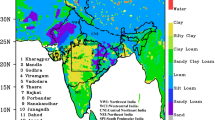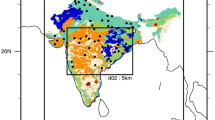Abstract
The micrometeorological observations, collected over a station in Ranchi (23°45′N, 85°30′E) which is under the monsoon trough region of India, were used in the Noah-LSM (NCEP, OSU, Air Force and Office of Hydrology Land Surface Model) to investigate the model performance in wet (2009 and 2011) and dry (2010) conditions during the south-west summer monsoon season. With this analysis, it is seen that the Noah-LSM has simulated the diurnal cycle of heat fluxes (sensible and ground) reasonably. The simulated heat fluxes were compared with its direct measurements by sonic anemometer and soil heat flux plate. The net radiation and sensible heat flux are simulated well by the model, but the simulation of ground heat flux was found to be poor in both dry as well as wet conditions. The soil temperature simulations were also found to be poor in 0–5- and 5–10-cm layers compared to other deeper layers. The observations were also correlated with the Modern Era Retrospective-analysis for Research and Applications (MERRA) data. The correlation between the observations and ground heat flux was better in MERRA dataset than that of the Noah-LSM simulation.






Similar content being viewed by others
References
Avissar R, Pielke RA (1989) A parameterization of heterogeneous land surfaces for atmospheric numerical models and its impact on regional meteorology. Mon Weather Rev 117(10):2113–2136
Betts AK, Chen F, Mitchell KE, Janji ZI (1997) Assessment of the land surface and boundary layer models in two operational versions of the NCEP Eta model using FIFE data. Mon Weather Rev 125(11):2896–2916
Charney JG (1975) Dynamics of deserts and droughts in the Sahel. Quart J Roy Meteor Soc 101(428):193–202
Charney JG, Quirk WJ, Chow SH, Kornefield J (1977) A comparative study of the effects of albedo change on drought in semi-arid regions. J Atmos Sci 34(9):1366–1385
Chen F, Mitchell K, Schaake J, Xue Y, Pan HL, Koren V, Duan QY, Ek M, Betts A (1996) Modeling of land surface evaporation by four schemes and comparison with FIFE observations. J Geophys Res 101(D3):7251–7268
Chen F, Janjic Z, Mitchell K (1997) Impact of atmospheric surface-layer parameterizations in the new land-surface scheme of the NCEP mesoscale Eta model. Bound Lay Meteorol 85:391–421
Chen YK, Yang J, He J, Qin J, Shi J, Du, He Q (2011) Improving land surface temperature modeling for dry land of China. J Geophys Res 116, D20104. doi:10.1029/2011JD015921
Ek MB, Cuenca RH (1994) Variation in soil parameters: implications for modeling surface fluxes and atmospheric boundary-layer development. Bound Lay Meteorol 70(4):369–383
Ek MB, Mitchell KE, Lin Y, Rogers E, Grunmann P, Koren V, Gayno G, Tarpley JD (2003) Implementation of Noah land surface model advances in the National Centers for Environmental Prediction operational mesoscale Eta model. J Geophys Res 108(D22):8851. doi:10.1029/2002JD003296
Gutman G, Ignatov A (1998) The derivation of the green vegetation fraction from NOAA/AVHRR data for use in numerical weather prediction models. Int J Rem Sens 19(8):1533–1543
Han Z, Ueda H, An J (2008) Evaluation and inter-comparison of meteorological predictions by five MM5-PBL parameterizations in combination with three land surface models. Atmos Environ 42(2):233–24
Kahan DS, Xue Y, Allen SJ (2006) The impact of vegetation and soil parameters in simulations of surface energy and water balance in the semi-arid Sahel: a case study using SEBEX and HAPEX-Sahel data. J Hydrol 320(1–2):238–259
Kalnay E, Kanamitsu M (1988) Time schemes for strongly nonlinear damping equations. Mon Weather Rev 116:1945–1958
Koren V, Schaake J, Mitchell K, Duan QY, Chen F, Baker J (1999) A parameterization of snowpack and frozen ground intended for NCEP weather and climate models. J Geophys Res 104(D16):19569–19585
Koster RD et al (2004) Regions of strong coupling between soil moisture and precipitation. Science 305:1138–1140
Koster RD et al (2006) GLACE: the global land–atmosphere coupling experiment. Part I: overview. J Hydrometeorol 7:590–610
Li B, Avissar R (1994) The impact of spatial variability of land-surface characteristics on land-surface heat fluxes. J Clim 7(4):527–537
Liang X, Guo J (2003) Inter-comparison of land-surface parameterization schemes: sensitivity of surface energy and water fluxes to model parameters. J Hydrol 279(1–4):182–209
Mahrt L, Ek M (1984) The influence of atmospheric stability on potential evaporation. J Appl Meteorol 23(2):222–234
Mahrt L, Pan H (1984) A two-layer model of soil hydrology. Bound Lay Meteorol 29:1–20
Oleson KW, Driese KL, Maslanik JA, Emery WJ, Reiners WA (1997) The sensitivity of a land surface parameterization scheme to the choice of remotely sensed land-cover datasets. Mon Weather Rev 125(7):1537–1555
Pan HL, Mahrt L (1987) Interaction between soil hydrology and boundary layer development. Bound Lay Meteorol 38:185–202
Panda J, Sharan M (2012) Influence of land-surface and turbulent parameterization schemes on regional-scale boundary layer characteristics over northern India. Atmos Res 112:89–111
Patil MN, Sinha S (2006) Soil temperature distribution with vegetation and rainfall over semi-arid region of western India. Mausam 57(4):688–694
Patil MN, Waghmare RT, Halder S, Dharmaraj T (2011) Performance of Noah land surface model over the tropical semi-arid conditions in western India. Atmos Res 99:85–96
Peters-Lidard CD, Zion MS, Wood EF (1997) A soil-vegetation-atmosphere transfer scheme for modeling spatially variable water and energy balance processes. J Geophys Res 102(D4):4303–4324
Peters-Lidard CD, Blackburn E, Liang X, Wood EF (1998) The effect of soil thermal conductivity parameterization on surface energy fluxes and temperatures. J Atmos Sci 55:1209–1224
Rajendran K, Nanjundiah R, Srinivasan J (2002) Comparison of seasonal and intra-seasonal variation of tropical climate in NCAR CCM2 GCM with two different cumulus schemes. Meteorog Atmos Phys 79:57–86
Rao YP (1976) Southwest monsoon. Meteorological monograph. Synoptic meteorology 1/1976: India Meteorological Department, New Delhi, pp 367
Reichle RH, Koster RD, De Lannoy GJM, Forman BA, Liu Q, Mahanama SPP, Toure A (2011) Assessment and enhancement of MERRA land surface hydrology estimates. J Clim 24:6322–6338. doi:10.1175/JCLI-D-10-05033.1
Sato N, Sellers PJ, Randall DA, Schneider EK, Shukla J, Kinter JL III, Hou YT, Albertazzi E (1989) Effects of implementing the simple biosphere model in a general circulation model. J Atmos Sci 46(18):2757–2782
Schaake JC, Koren VI, Duan QY, Mitchell K, Chen F (1996) Simple water balance model for estimating runoff at different spatial and temporal scales. J Geophys Res 101(D3):7461–7475
Sikka DR, Narasimha R (1995) Genesis of the monsoon trough boundary layer experiment (MONTBLEX). Proc Ind Acad Sci (Earth and Planetary Science) 104:157–187
Waghmare RT, Dharmaraj T, Patil MN (2012) Noah-LSM simulation on various soil textures in tropical semi-arid regions. Soil Sci 177:664–673
Zeng XM, Zhao M, Su BK, Tang JP, Zheng YQ, Zhang YJ, Chen J (2002) The effects of land-surface heterogeneities on regional climate: a sensitivity study. Meteorog Atmos Phys 81(1–2):67–83
Acknowledgments
The authors express their gratitude to Prof. B. N. Goswami, Director, IITM, Pune for the encouragement. The observational program was sponsored and financed by the Department of Science and Technology, Govt. of India. We are also thankful to the Vice Chancellor of Birla Institute of Technology, Mesra, Ranchi for providing the entire infrastructure to conduct the experiment and to establish the land surface atmosphere and micrometeorological observational system (LATAMOS) in the campus. We are thankful to an anonymous reviewer for the constructive suggestions that helped to improve the manuscript.
Author information
Authors and Affiliations
Corresponding author
Rights and permissions
About this article
Cite this article
Patil, M.N., Kumar, M., Waghmare, R.T. et al. Evaluation of Noah-LSM for soil hydrology parameters in the Indian summer monsoon conditions. Theor Appl Climatol 118, 47–56 (2014). https://doi.org/10.1007/s00704-013-1046-2
Received:
Accepted:
Published:
Issue Date:
DOI: https://doi.org/10.1007/s00704-013-1046-2




